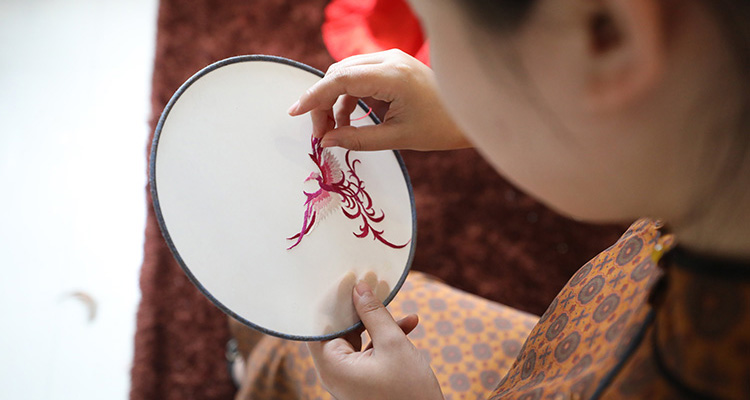Beijing Embroidery: The Royal Art at Your Fingertips
Discover the beauty and history of Beijing Embroidery, a royal art of silk, gold threads, and cultural heritage.
1. What Is Beijing Embroidery? – Definition & First Impressions
Beijing Embroidery, also called Jing Xiu or Palace Embroidery, is one of China’s most exquisite traditional arts. Originating in Beijing, it was once the pride of the imperial court, where each piece of Chinese Embroidery carried royal symbolism and cultural significance.
When you first see a piece of Beijing Embroidery, its rich colors and luxurious shine immediately catch your eye. The silk threads glimmer with life, and the gold and silver threads sparkle brilliantly under light, creating a regal effect. Dragons appear to leap off robes, and peonies almost seem to release their fragrance.
For tourists exploring Beijing, beyond the Forbidden City and the Great Wall, experiencing this royal art offers a glimpse into centuries of craftsmanship and imperial aesthetics. Even a casual walk through a local workshop can transport you to the elegance of China’s dynasties.

2. Its Story – History & Cultural Significance
Origins and Evolution
The history of Beijing Embroidery is long and fascinating. It can be traced back to the Tang Dynasty, when silk weaving in Beijing started flourishing. By the Ming and Qing dynasties, Jing Xiu had reached its peak, joining the ranks of China’s four major embroidery traditions. The craft served only the royal family, with strict rules for patterns, symbols, and colors.
Every motif carried a story: dragons represented imperial authority, phoenixes symbolized the empress, and peonies stood for wealth. Colors were just as important—yellow was exclusive to the emperor, red conveyed joy, and black added depth and dignity. Using the wrong color or pattern could have been considered a serious offense, even hinting at treason!
Cultural Value
Beijing Embroidery is more than just art; it is a reflection of Chinese culture. Every stitch is intentional, every design meaningful. This heritage art conveys centuries of history and philosophy, showing how craftsmanship and cultural values intertwine. Today, it is recognized as a national intangible cultural heritage, preserving a piece of royal China for future generations.

3. How Is It Created? – Materials, Techniques & Elements
Materials and Tools
Creating Beijing Embroidery requires the finest materials:
- Silk threads dyed in vibrant colors
- Gold and silver threads twisted for shimmering details
- Satin and high-quality fabrics
- Tools like needles, hoops, and frames
Step-by-Step Crafting
- Designing Patterns: Artisans sketch designs on wax paper.
- Punching Holes: Tiny holes are made along the lines of the design.
- Transferring the Design: Special powder passes through the holes to imprint the pattern on fabric.
- Embroidering: Using dozens of needle techniques, the design comes to life.

Techniques and Styles
Jing Xiu features a variety of stitches: Flat Gold Embroidery, Seed Stitching, and Looped Gold. Among them, the “Flat Gold with Seed Stitch” is considered the pinnacle, combining gold threads and tiny decorative knots for a luxurious, textured effect.
Unlike the subtle realism of southern Chinese embroidery, Beijing Embroidery is vivid, layered, and ornate. Its bright yet sophisticated colors create an elegant and historical atmosphere, perfect for those who love both art and culture.

4. How to Appreciate & Engage – Viewing Tips & Interactive Experiences
Tips for Appreciation
When you admire Beijing Embroidery, look for:
- Even stitches that are neat and precise
- Lustrous silk threads, reflecting light beautifully
- Symbolic patterns, like bats for good luck or peonies for prosperity
- Double-sided work, where both sides display the same intricate design
Hands-On Experience
You don’t have to just watch! In Beijing, you can:
- Join workshops guided by master artisans to create a small embroidered sachet
- Visit flagship stores, like “Yu Xun Jing Xi” at Wangfujing, where you can try “flying needles and flowing threads” under guidance
- Feel the silk, sense the rhythm of needle and thread, and truly appreciate the skill required
Experiencing this imperial craft firsthand gives you a deeper understanding of its complexity and beauty.

5. Where to Experience It – Preservation & Learning Opportunities
Preservation Efforts
Though once at risk due to changing markets and fewer artisans, Beijing Embroidery is making a strong comeback:
- 2014 Recognition: Listed as a national intangible cultural heritage
- Master Artisans: Experts like Liu Xiuhua and Sun Ying are dedicated to teaching the craft
Where to Try It
Tourists can experience Jing Xiu at:
- Zhongshan Park Music Hall: Regular workshops with heritage artisans
- Wangfujing Gongmei Building: Four-story flagship with exhibition and hands-on experience
- Daoxianghu Intangible Cultural Heritage City: Home to master workshops for in-depth learning
Learning More
Visitors can:
- Follow workshops and events hosted by heritage studios
- Check official WeChat accounts for hands-on experiences and cultural activities
- Participate in exhibitions to appreciate the royal craft fully
Through these experiences, you can connect with Beijing culture, feel history under your fingertips, and understand the royal aesthetics that shaped this centuries-old art.


